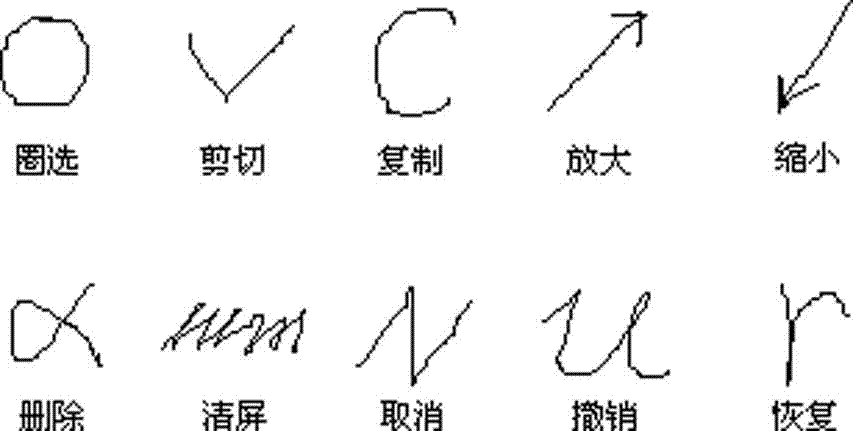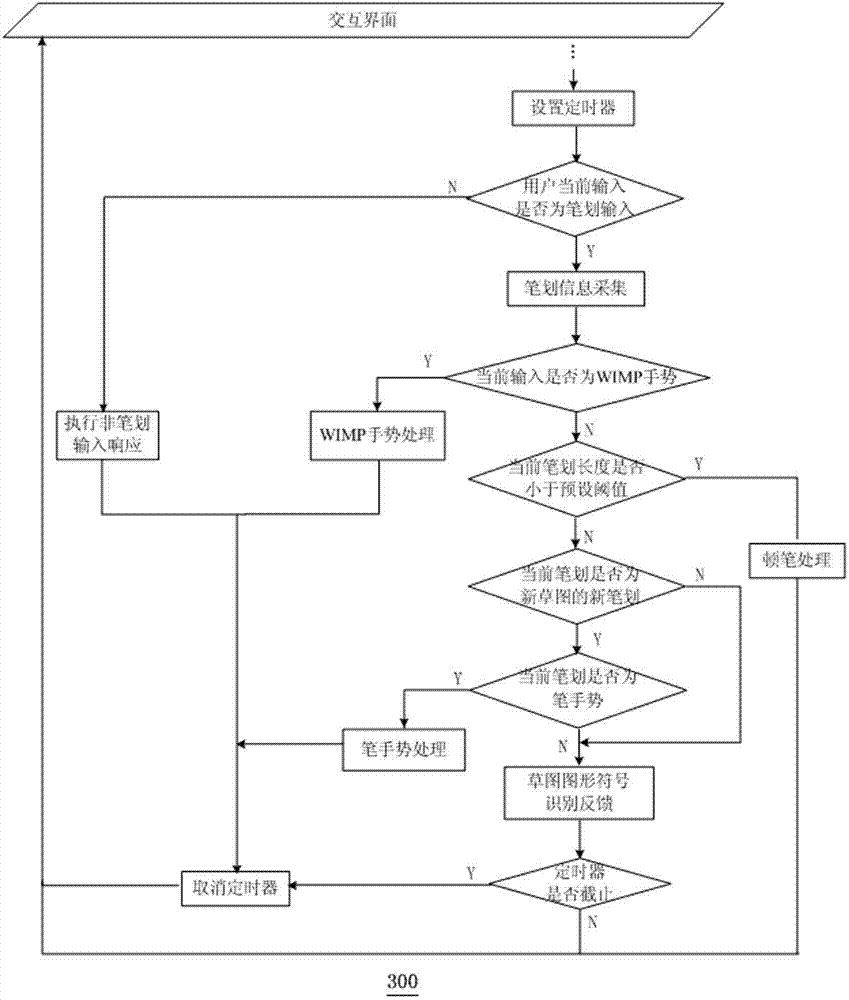Pen type interactive method based on free-hand sketch and gesture input judging and processing
A judgment processing and gesture input technology, applied in the field of human-computer interaction, can solve the problems of limited types of gesture recognition, increase in the size of the basic graphics set, lack of interactive feedback mechanism, gesture interaction research, etc. Simplicity and the effect of improving interaction efficiency
- Summary
- Abstract
- Description
- Claims
- Application Information
AI Technical Summary
Problems solved by technology
Method used
Image
Examples
Embodiment 1
[0061] see image 3 , Figure 4 , using "circular" input as an illustration example of the present invention to specifically illustrate the steps of method 300 and method 400:
[0062] (1) After the user's current input is completed, set a timer to judge whether the user's current input is a stroke input. If so, collect the current original stroke information and transfer to (3), otherwise transfer to (2);
[0063] (2) Cancel the timer, execute non-stroke input response, and transfer to (9);
[0064] (3) Determine whether the current stroke is a WIMP gesture, if so, perform WIMP gesture processing, cancel the timer, and turn to (9), otherwise turn to (4);
[0065] (4) Judging whether the length of the current stroke is less than a certain preset threshold, if so, perform pause processing, and turn to (9), otherwise turn to (5);
[0066] (5) Judging whether the current original stroke is a new stroke of a new sketch, if yes, turn to (6), otherwise turn to (7);
[0067] (6) ...
Embodiment 2
[0072] The steps of method 300 and method 400 are specifically described by using "polyline" input as another example of the present invention:
[0073] (1) After the user's current input is completed, set a timer to judge whether the user's current input is a stroke input. If so, collect the current original stroke information and transfer to (3), otherwise transfer to (2);
[0074] (2) Cancel the timer, execute non-stroke input response, and transfer to (9);
[0075] (3) Determine whether the current stroke is a WIMP gesture, if so, perform WIMP gesture processing, cancel the timer, and turn to (9), otherwise turn to (4);
[0076] (4) Judging whether the length of the current stroke is less than a certain preset threshold, if so, perform pause processing, and turn to (9), otherwise turn to (5);
[0077] (5) Judging whether the current original stroke is a new stroke of a new sketch, if yes, turn to (6), otherwise turn to (7);
[0078] (6) Obtain the original information of...
Embodiment 3
[0083] see image 3 , Figure 5 , each step of the method 300 and the method 500 is illustrated by taking the stroke input smaller than the preset threshold as another example.
[0084] (1) After the user's current input is completed, set a timer to judge whether the user's current input is a stroke input. If so, collect the current original stroke information and transfer to (3), otherwise transfer to (2);
[0085] (2) Cancel the timer, execute non-stroke input response, and transfer to (9);
[0086] (3) Determine whether the current stroke is a WIMP gesture, if so, perform WIMP gesture processing, cancel the timer, and turn to (9), otherwise turn to (4);
[0087] (4) Obtain the original stroke information, determine that the length of the current stroke is less than a preset threshold, and perform pause processing;
[0088] (5) Judge whether the current stroke is a new stroke of a new sketch, if so, go to (6), otherwise go to
[0089] enter(7);
[0090] (6) Determine wh...
PUM
 Login to View More
Login to View More Abstract
Description
Claims
Application Information
 Login to View More
Login to View More - R&D
- Intellectual Property
- Life Sciences
- Materials
- Tech Scout
- Unparalleled Data Quality
- Higher Quality Content
- 60% Fewer Hallucinations
Browse by: Latest US Patents, China's latest patents, Technical Efficacy Thesaurus, Application Domain, Technology Topic, Popular Technical Reports.
© 2025 PatSnap. All rights reserved.Legal|Privacy policy|Modern Slavery Act Transparency Statement|Sitemap|About US| Contact US: help@patsnap.com



